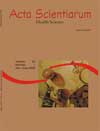<b>Study of the myoepithelial cell differentiation state in salivary gland tumors</b> - DOI: 10.4025/actascihealthsci.v26i2.1587
Abstract
The myoepithelial cell (MC) in salivary gland tumors is presented at different stages of differentiation. The cell presents specific muscles actin (SMA) and Citokeratin (CK)14 in normal gland. On the other hand, there is a participation of extracellular matrix components, as the laminin (LN), in the morphogenesis and cito differentiation of the glands structures. Considering that, we decided to study the different stages of the MC differentiation through SMA expression, the CK 14, as well as the LN participation in this process. Tumors which present the MC participation were used: pleomorphic adenoma, myoepithelioma, adenoma of basal cells, adenoid cystic carcinoma. The immunohistochemical of avidine-biotine analysis of the specimens was done. Results showed that the presence of SMA was rare, as well as the presence of CK 14 that was only noticed on the well formed ductiforms structures. On the other hand, LN was presented adjacent to the MC, independently on the expression of CK 14 and SMA, and in the strom of the differentiated and indifferentiated tumors. Results show that it is possible to identify different stages of myoepithelial differentiation through CK 14 and SMA expression, but it seems there is not a correlation between the LN and the MC tumor differentiation, considering that the MC tumor differentiation keeps secreting LN, even if defectively after oncogenic stimulus.Downloads
Download data is not yet available.
Published
2008-03-31
How to Cite
Raitz, R., & Araújo, V. C. de. (2008). <b>Study of the myoepithelial cell differentiation state in salivary gland tumors</b> - DOI: 10.4025/actascihealthsci.v26i2.1587. Acta Scientiarum. Health Sciences, 26(2), 345-350. https://doi.org/10.4025/actascihealthsci.v26i2.1587
Issue
Section
Dentistry Articles
DECLARATION OF ORIGINALITY AND COPYRIGHTS
I Declare that current article is original and has not been submitted for publication, in part or in whole, to any other national or international journal.
The copyrights belong exclusively to the authors. Published content is licensed under Creative Commons Attribution 4.0 (CC BY 4.0) guidelines, which allows sharing (copy and distribution of the material in any medium or format) and adaptation (remix, transform, and build upon the material) for any purpose, even commercially, under the terms of attribution.
Read this link for further information on how to use CC BY 4.0 properly.























5.png)







